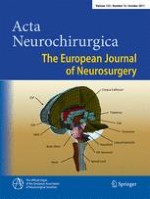01-10-2011 | Clinical Article
Endoscopic third ventriculostomy for hydrocephalus after perimesencephalic subarachnoid hemorrhage: initial experience in three patients
Published in: Acta Neurochirurgica | Issue 10/2011
Login to get accessAbstract
Background
To review the outcome after endoscopic third ventriculostomy (ETV) for symptomatic, persistent hydrocephalus in three patients with perimesencephalic angiographically negative subarachnoid hemorrhage (PNH) who were dependent on an external ventricular drain (EVD).
Methods
All patients initially presented with severe headache, nuchal rigidity, confusion and lethargy (Hunt-Hess Grade II or III), and persistent, EVD-dependent hydrocephalus. Cranial CT images in each revealed acute hydrocephalus and perimesencephalic hemorrhage pattern with a heavy clot burden (Fisher grade 3). A 3D-CT angiogram on admission and two four-vessel cerebral angiograms failed to demonstrate a bleeding source. All three patients failed trial EVD clamping, with clinical deterioration and elevated intracranial pressure (ICP). ETV was performed with a 0-degree endoscope in a 4.6-mm irrigating sheath using an endoscopic-coring/“cookie-cut” technique. An EVD was left in place for postoperative ICP monitoring but was clamped.
Results
ETV was accomplished in all patients. In one case, a tiny basilar tip aneurysm was seen during the endoscopic procedure. Intraoperatively, the prepontine cistern revealed dense, degraded blood products. Postprocedure ICP measurements were reduced to normal range. Clinical improvement, normal ICP readings, and/or radiographic evidence of resolution of hydrocephalus allowed uneventful removal of the EVD within 36–48 h post-ETV in all patients. All remained headache-free, with a normal neurological examination, during a follow-up period of 10, 11, and 12 months, respectively.
Conclusion
To our knowledge, this is the first report of ETV for PNH with hydrocephalus and the first report of a basilar tip microaneurysm seen intraoperatively during ETV. ETV is a viable treatment option for refractory hydrocephalus secondary to a perimesencephalic pattern of subarachnoid hemorrhage (SAH). Its early application can avoid placement of a ventriculoperitoneal shunt, curtail the extended use of an EVD, and reduce the associated infection risks. Despite thorough angiographic investigation for an aneurysmal cause of SAH, a “microaneurysm” of the basilar artery was found at ETV. No complication or rebleeding was encountered.





